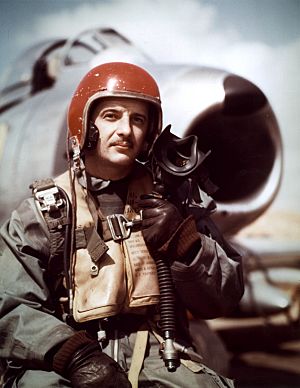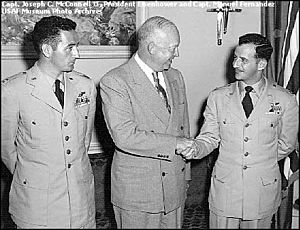Manuel J. Fernandez facts for kids
Quick facts for kids
Manuel John Fernandez, Jr.
|
|
|---|---|

Capt. Manuel J. Fernandez, Jr. of the 334th Fighter-Intercepter Squadron became the third highest ace in the Korean War with 14 1/2 kills.
|
|
| Nickname(s) | Pete |
| Born | April 19, 1925 Key West, Florida |
| Died | October 18, 1980 (aged 55) Grand Bahama Island, The Bahamas |
| Buried | |
| Allegiance | United States |
| Service/ |
United States Army Air Forces United States Air Force |
| Years of service | 1943–1963 |
| Rank | Major |
| Unit | 334th Fighter-Interceptor Squadron |
| Battles/wars | World War II Berlin Airlift Korean War |
| Awards | Distinguished Service Cross Silver Star Distinguished Flying Cross (2) Air Medal (2) |
| Other work | 1956 Bendix Trophy Air Race winner |
Manuel John "Pete" Fernandez, Jr. (born April 19, 1925 – died October 18, 1980) was a brave American pilot. He became the third-highest scoring ace for the United States Air Force during the Korean War. An "ace" is a pilot who shoots down five or more enemy aircraft. Pete Fernandez earned the Distinguished Service Cross for his amazing courage in Korea.
Contents
Early Life and Flying Dreams
Pete Fernandez was born in Key West, Florida, on April 19, 1925. His grandparents came from Spain and lived in Cuba before moving to the United States. Pete grew up in Miami. His father loved amateur radio and later became a chief radio operator for Pan American World Airways.
Pete was surrounded by aviation from a young age. He learned to fly planes even before he could drive a car! He earned his private pilot's license when he was just fifteen years old. In 1943, he graduated from Andrew Jackson High School in Miami.
A Career in the Skies
Joining the Military
Pete Fernandez joined the Army Air Corps in February 1943. Even though he was small and had just finished high school, he joined the Aviation Cadet Program. In November 1944, he became a second lieutenant and earned his pilot wings. This showed his great talent and determination.
His first jobs were as a pilot instructor. He taught flying in places like Midland, Texas, San José, Guatemala, and Panama. He did not see any combat during World War II.
Helping in the Berlin Airlift
After World War II, Pete re-enlisted in the U.S. Air Force. He helped with the Berlin Airlift between 1948 and 1949. This was a huge effort to fly supplies into Berlin, Germany. The city was blocked by the Soviet Union, so planes had to deliver everything people needed.
Pete's squadron, the 23rd Fighter Squadron, was sent to Germany. Their job was to protect the slow transport planes that were bringing in supplies.
Becoming a Korean War Ace
After almost ten years in the military, Captain Fernandez finally got to experience combat. This happened during the Korean War. From September 1952 to May 1953, he flew 124 missions. He was part of the 334th Fighter-Interceptor Squadron.
Pete became one of the best combat pilots of his time. He was known for being very skilled in air battles. He would only fire his guns when he was in the perfect position to hit the enemy. Like other top aces, he sometimes flew into Chinese airspace to find enemy MiG jets. He was also known for taking care of his fellow pilots and not being reckless.
In Korea, Pete became the third-highest ranking American ace. He shot down 14.5 enemy planes. What's amazing is that he achieved this record in a very short time, about nine months!

In May 1953, Fernandez was ordered to leave Korea. The Air Force often sent its top aces home early to keep them safe. At that time, Pete was the number one ace.
Pete returned home at the same time as his friend Joe McConnell. Joe was the "ace of aces" with sixteen kills. Both pilots received a hero's welcome. They had parades and received special keys to many cities. The new president, Dwight Eisenhower, invited them to the White House.
Hollywood and Beyond
Movies About Aces
After the war, a big Hollywood movie was planned about Joe McConnell. It was called Tiger In The Sky. Pete Fernandez was stationed near Los Angeles at the time. He was chosen to be the movie's technical advisor. This meant he helped make sure the flying scenes looked real, and he even flew some stunts himself!
Sadly, Joe McConnell was killed in a test flight accident in August 1954. The movie was then renamed The McConnell Story. It included the tragic ending and was released in 1955. The film starred Alan Ladd and June Allyson. It was more of a love story than a war movie.
Pete Fernandez became friends with June Allyson on the movie set. After filming, she and her husband, Dick Powell, invited Pete and his family to their ranch. Pete shared his combat stories with Dick Powell, who was also a filmmaker. Powell's next movie was a Korean War air combat film called The Hunters. It starred Robert Mitchum and Robert Wagner. This movie, released in 1958, had much more realistic combat scenes than The McConnell Story. Pete Fernandez and two other top Korean War aces attended the movie premiere.
Winning the Bendix Trophy Race
In 1956, Pete Fernandez won the famous Bendix Trophy Race. This was an aviation competition where pilots tried to fly as fast as possible while using fuel efficiently. Pete used old tricks he learned during the war to win.
All six pilots in the 1956 race were experienced Air Force fighter pilots. They all flew the same plane, the USAF's newest fighter, the F-100 Super Sabre. The race route was from Los Angeles to Oklahoma City, a distance of 1,118 miles.
Pete stayed up late the night before the race. He carefully planned his flight to get the most out of every drop of fuel. On August 31, the planes took off at dawn. Pete was the first to go. When his F-100 crossed the finish line in Oklahoma City, he had only twenty gallons of fuel left. That was enough to stay airborne for about one minute! Just like in Korea, careful planning helped Pete win the Bendix Trophy.
Later Career and Retirement
Pete Fernandez continued to serve in the Air Force. He was stationed at Edwards Air Force Base in California. After learning Spanish, he was sent to Buenos Aires, Argentina, in 1960. There, he advised the Argentine Air Force. He retired from the Air Force as a Major on July 1, 1963, after twenty years of service.
Death and Legacy
Pete Fernandez died in a plane crash on October 18, 1980. He is buried at Arlington National Cemetery.
Awards and Decorations
Pete Fernandez received many awards for his bravery and service. These include:
- Distinguished Service Cross
- Silver Star
- Distinguished Flying Cross (with one oak leaf cluster)
- Air Medal (with one oak leaf cluster)
- Air Force Commendation Medal
- Air Force Presidential Unit Citation
- Army Good Conduct Medal
- American Campaign Medal
- World War II Victory Medal
- Army of Occupation Medal (with Berlin Airlift Device)
- National Defense Service Medal (with one bronze service star)
- Korean Service Medal (w/ 3 bronze campaign stars)
- Air Force Longevity Service Award (w/ 4 bronze oak leaf clusters)
- Armed Forces Reserve Medal
- Republic of Korea Presidential Unit Citation
- United Nations Korea Medal
- Korean War Service Medal
Images for kids
See also
- List of Korean War air aces
- Hispanics in the United States Air Force


